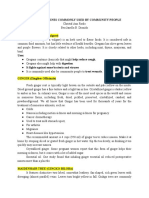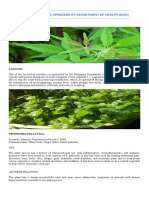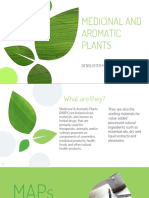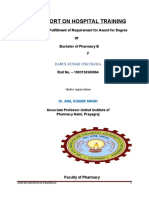Giloy Is Amrita
Giloy Is Amrita
Uploaded by
akshayhazari8281Copyright:
Available Formats
Giloy Is Amrita
Giloy Is Amrita
Uploaded by
akshayhazari8281Original Title
Copyright
Available Formats
Share this document
Did you find this document useful?
Is this content inappropriate?
Copyright:
Available Formats
Giloy Is Amrita
Giloy Is Amrita
Uploaded by
akshayhazari8281Copyright:
Available Formats
Giloy is Amrita
Written by Dr. Sanjeev Sood & R.D. Gupta
Dr. Sanjeev Sood Ph. : +91-9814004142 Giloy is one of the most useful ayurvedic herb which acts as tonic and aphrodisiac, it is also an antihelminthic, anti-arthritic, anti-periodic, anti-pyretic, blood purifier, cardiac, carminative, digestive, diuretic an expectorant, stomachic, rejuvenating, appetizing and antiinflammatory.
In Ayurvedic literature Giloy is described as Amrita because of its innumerable medicinal properties and it is also said to increase the lifespan of humans by preventing them from many chronic diseases. Giloy is one of the most useful ayurvedic herb which acts as tonic and aphrodisiac, it is also an antihelminthic, anti-arthritic, anti-periodic, anti-pyretic, blood purifier, cardiac, carminative, digestive, diuretic an expectorant, stomachic, rejuvenating, appetizing and anti-inflammatory. Starch from the roots of Giloy as well as from its stems can be used for chronic diarrhoea and dysentery. The juice of the fresh plant is diuretic and is used in gonorrhea. It is also useful for curing chronic fevers, gouts, vomiting, cardiac debility, skin diseases, leprosy, anemia, cough, asthma, jaundice, seminal weakness, uropathy and splenopathy. Tinospora cordifolia (Wild) Miers Ex. HK. F Thomas, which is commonly known as Giloy or Gudachia. It belongs to the family of Menispermaceae and is a vigorous climber. Its English name is Gulancha Tinospora. There are about 40 species of Giloy which are found throughout the world, comprising parts of Africa, Southern Eastern Asia, and Australia. Out of 40 species only 4 species have been found in India. These consist of : (i) Tinospora cardifolia; (ii) T. sinensis; (iii) T. malabarica; and (iv) T. tomentosa. T. cardifolia is, however, mainly found in the tropical and subtropical regions of India ascending an altitude of 300 m to 1200 m above mean sea level. Contrary to this, T. malabarica grows up to 1300 m above mean sea level. Both these species are found in association with each other in the warmer and mainly valley areas of Uttarakhand. In fact, T. cordifolia is an indigenous plant species belonging to the tropical areas of India, Myanmar and Sri Lanka. It is an important herb used in traditional Ayurvedic medicine. Medicinal uses: Skin diseases: Juice taken with neem, haldi and amla is very effective. Piles: Juice of Tinospora with butter milk is useful. Breast milk: Decoction of the stem is given to improve the quality of breast milk. Toxins: It is considered a best herb for clearing microcirculatory system. Its juice is very effective in removing both exogenous and endogenous toxins. It clears out the brain toxin that inhibits mental function. Asthma: The root and bark with whey is used in the treatment of respiratory troubles particularly in asthma. Diabetes: Juice is taken in high quantities. Excessive bleeding during menstruation, bleeding after abortion or delivery: Stem, leaves and roots can be used. About 5 g each of leaves and roots are crushed together to extract the juice. Consume 2 cup of this juice for a few days after diluting it with water (2 to 3 ml in half a cup of water) till the condition improve. Malaria and other fever : Decoction of the stem with pipli (Piper longum) and honey is taken. Indigestion: The juice with honey or the paste of leaves can be given with butter milk. Conjuctivitis and cataract : In some parts of India the juice is applied inside the eyes. Giloy Dosage Powder 1-2 gm. up to maximum 5 gm. Decoction 50-100 ml Extract 1-2 ml Giloy is a large extensively spreading, glabrous, perennial, deciduous climber having succulent stems and corky dotted bark with grey-brown or creamy-white color. The leaves are simple, membranous, alternate broadly ovate, deeply cordate and shortly acuminate. Its flowers are small, yellow or greenish-yellow in appearance when the plant is leafless. They are usually solitary in the female and clustered in the male plant. The fruits are generally drupes and red in color when they ripe. The drupes are ovoid, glossy, succulent, red and seeds are curved. Usually, fruits bear only one seed. The flowering in Giloy usually starts in the month of March-June and fruit set in the month of July and mature in the cold season. The most important part of the plant used for therapeutic purpose is fresh stem, though it is commercially available in the market (Grocer's shops) in the dried state. The main important chemical constituent of the plant are tinosporin, perberillin, palmarin, berberine, tinosporon, hepta consol tinosporic acid adntinosporol. The fresh stem bark yield giloin, giloinin and gilosterol. Hypoglycaemia agent and phenolic lignin have also been isolated from this plant.
Other uses It is used in cancer prevention, cancer treatment support, high cholesterol and liver protection. It is used as strong antiaging factor. Many natives use the fruits of Tinospora in face care. It has been used to treat convalescence from severe illness, arthritis, food allergies and anemia. According to some herbalists, Tinospora has adaptogen effects, a term that indicates it helps the body to adopt to stress. In children it is used in general debility, digestive disturbance, loss of appetite and fever. Giloy can be successfully grown in large variety of soils, ranging from loamy sand/sandy loam or loam to clay loam. However, the soil should be well drained with sufficient moisture. Planting is usually done during rainy season (July to August). As it is climber so it requires support. Fast growing species such as Jatropha (Jatropha curcas) and Moringa (Moringa oleifera) are planted for providing support to Giloy plant. Propagation through seeds and cuttings: Although Giloy is propagated through seeds and cuttings yet propagation through cutting is cheaper and easy as compared to seeds. Cuttings do not require any chemical treatments which enhance the rooting before planting. As such they are propagated from cuttings of the plants within 24 hours. The main precaution is that the cuttings should have at least two internodes. One is put inside the soil surface and the other one should remain outside the soil surface. In case of seeds propagation, it requires some chemical treatments before sowing in the nursery bed. Initially at the time of planting, watering is required daily while during winter it can be done once in a week depending upon climatic conditions. The powder is taken in empty stomach with half cup of water in the morning. The decoction is taken after diluting with half a glass of water early in the morning in empty stomach. The extract is also taken early in the morning in empty stomach after mixing with half a glass of water. In Ayurvedic products Giloy plant is used for the preparation of various types of ayurvedic products like Yograja guggulu, Kaishore guggulu, Sanjivani-vati, Amritarista, Sudarshan churan. Parts of Giloy used for curing diseases StemFever, Acidity, Blood purification and Eye disease FruitRheumatism, Jaundice RooLeprosy LeavesRheumatism Dr. Sanjeev Sood is Prof. & Head of Panchakarma Department, Dayanand Ayurvedic College, Jalandhar, + 91 9814004142 drsanjeevsood@yahoo.com Mr. R.D. Gupta is Ex-Associate Dean, Sher-e-Kashmir University of Agricultural Sciences and Technology (J), 39-Dhakki Sarajan, Jammu 180001 (J&K).
You might also like
- Legal Medicine Review Questions WITH KEY ANSWERDocument6 pagesLegal Medicine Review Questions WITH KEY ANSWERlovelots123494% (31)
- Herbal PlantsDocument21 pagesHerbal Plantshan_angelaNo ratings yet
- Philcare Doctors - Visayas - 2013Document171 pagesPhilcare Doctors - Visayas - 2013Irish Balaba50% (2)
- ZCut Power Cardio Schedule PDFDocument3 pagesZCut Power Cardio Schedule PDFjosereci100% (2)
- Lagundi (Vitex Negundo)Document44 pagesLagundi (Vitex Negundo)lhhjklll75% (4)
- Coccinia Indica or Cephalandra IndicaDocument22 pagesCoccinia Indica or Cephalandra IndicaMagesh SNo ratings yet
- Bayabas: Bayabas or Guava (Psidium Guajava)Document13 pagesBayabas: Bayabas or Guava (Psidium Guajava)Stein Luib JaelNo ratings yet
- Herbal Medicines Commonly Used by Community PeopleDocument7 pagesHerbal Medicines Commonly Used by Community PeopleHannah VillavicencioNo ratings yet
- 10 Herbal MedsDocument4 pages10 Herbal Medsesmekylie02No ratings yet
- Moringa Medicinal BenefitsDocument8 pagesMoringa Medicinal BenefitsShiro ChanNo ratings yet
- LAGUNDIDocument8 pagesLAGUNDIMae VisperasNo ratings yet
- PansitDocument9 pagesPansitLouieJay Masion Jadraque BialanNo ratings yet
- SantalubbyDocument10 pagesSantalubbyMark Cruze100% (1)
- 10 Herbal MedicinesDocument7 pages10 Herbal MedicinesJulYan 0711No ratings yet
- Herbal Medicines Approved by Department of Health DohDocument5 pagesHerbal Medicines Approved by Department of Health DohDenise Danielle TorresNo ratings yet
- DOH 13 Herbal MedicineDocument37 pagesDOH 13 Herbal MedicineBroward MadrioNo ratings yet
- HP Smart Web Printing BottleDocument2 pagesHP Smart Web Printing BottleSubramanya RaoNo ratings yet
- Ten Herbal DohDocument7 pagesTen Herbal DohBrianna ValerioNo ratings yet
- BayabasDocument6 pagesBayabasDaryl Rojas Gabriel QuindiaganNo ratings yet
- Herbal MedicineDocument6 pagesHerbal MedicineZerlin Duran100% (8)
- Ginger: SensitivityDocument6 pagesGinger: SensitivityMaría Arias100% (1)
- Herval PlantsDocument9 pagesHerval PlantsndcmauricioNo ratings yet
- Moringa: A Botanical PharmacopoeiaDocument4 pagesMoringa: A Botanical PharmacopoeiaFarhat DurraniNo ratings yet
- 10 Herbal Medicines Approved by DOHDocument10 pages10 Herbal Medicines Approved by DOHBeatrice ManingasNo ratings yet
- Appendix II Ayuvedic HerbsDocument8 pagesAppendix II Ayuvedic HerbsNeutron ZionNo ratings yet
- Medicinal and Aromatic Plants: Denslister M. MahilumDocument24 pagesMedicinal and Aromatic Plants: Denslister M. Mahilumdave mahilumNo ratings yet
- Americorps Project ProposalDocument5 pagesAmericorps Project ProposalNicholas CannonNo ratings yet
- Medicinal Plants: 50 natural treatments for healing all types of illnessesFrom EverandMedicinal Plants: 50 natural treatments for healing all types of illnessesNo ratings yet
- Doh ApprovedDocument10 pagesDoh ApprovedAlliyah SalindoNo ratings yet
- LagundiDocument10 pagesLagundiAnonymous Pploe6No ratings yet
- Ayurveda Medicinal Properties of Guduchi or Tinospora CardifoliaDocument2 pagesAyurveda Medicinal Properties of Guduchi or Tinospora CardifoliaHilary WatsonNo ratings yet
- My Backyard's Herbal PlantsDocument10 pagesMy Backyard's Herbal PlantsRegine AldamarNo ratings yet
- Alternative Health & Herbs Remedies 425 Jackson SE, Albany, OR 97321 1-541-791-8400Document159 pagesAlternative Health & Herbs Remedies 425 Jackson SE, Albany, OR 97321 1-541-791-8400Marvin T Verna100% (3)
- Constituents Par Ts U Sed Medicinalproperties: Avoca DoDocument40 pagesConstituents Par Ts U Sed Medicinalproperties: Avoca Doehem_4r2No ratings yet
- Herbal Medicine - 20240917 - 121907 - 0000Document14 pagesHerbal Medicine - 20240917 - 121907 - 0000Ina FuentesNo ratings yet
- Solanum Nigrum (The Nightshade)Document8 pagesSolanum Nigrum (The Nightshade)Bushra FathimaNo ratings yet
- Presentation (1)Document18 pagesPresentation (1)adhikarijubin0000No ratings yet
- Srilanka HerbsDocument6 pagesSrilanka HerbsSundara Veer Raju MEDNo ratings yet
- Botany AssignmentDocument4 pagesBotany AssignmentAbhishek KatreNo ratings yet
- Halamang GamotDocument7 pagesHalamang GamotHazel UntalanNo ratings yet
- Five Powerful African Herbs and Their Healing PropertiesDocument3 pagesFive Powerful African Herbs and Their Healing PropertiesdebteraNo ratings yet
- Moringa Oleifera - The Tree of LifeDocument3 pagesMoringa Oleifera - The Tree of LifeMohammad Rehan100% (1)
- Herbal PlantsDocument15 pagesHerbal PlantsKate Taguiam100% (1)
- Medicinal Plants in The PhilippinesDocument20 pagesMedicinal Plants in The PhilippinesFranz Banocnoc100% (1)
- Herbal Medicines in The PhilippinesDocument20 pagesHerbal Medicines in The Philippinesjava_biscocho122997% (33)
- Bitter Gourd or Karela Leaves Medicinal Uses - AspxDocument6 pagesBitter Gourd or Karela Leaves Medicinal Uses - AspxSanjay Patil100% (1)
- Ethnobotany of UttarkhandDocument9 pagesEthnobotany of Uttarkhandmrunknown2089No ratings yet
- MooligaiDocument33 pagesMooligaiRockety RyderNo ratings yet
- AMPALAYADocument7 pagesAMPALAYAMyzhel InumerableNo ratings yet
- Medicinal Uses of AmlaDocument9 pagesMedicinal Uses of AmlaKanishk AggarwalNo ratings yet
- Neem PresentationDocument9 pagesNeem PresentationO'Mark AndrewsNo ratings yet
- Herbal Plants Approved by DohDocument11 pagesHerbal Plants Approved by DohRhealyn IliganNo ratings yet
- Herbal MedicineDocument8 pagesHerbal MedicineStephanie Joy EscalaNo ratings yet
- Aloe VeraUsesDocument3 pagesAloe VeraUsesDeepraj GaonkarNo ratings yet
- Akapulko or Acapulco in English Is A Shrub Found Throughout The PhilippinesDocument6 pagesAkapulko or Acapulco in English Is A Shrub Found Throughout The PhilippinesJon Adam Bermudez SamatraNo ratings yet
- Medicinal Plants and TheirDocument23 pagesMedicinal Plants and Theirparimalar2753No ratings yet
- Clinical Use of HerbsDocument44 pagesClinical Use of HerbsAlishba MushtaqNo ratings yet
- Fenugreek Health Benefits and Medicinal UsesDocument15 pagesFenugreek Health Benefits and Medicinal UsesSanjay PatilNo ratings yet
- CHNHerbal MedicineDocument5 pagesCHNHerbal MedicineStephanie Joy Escala100% (1)
- 10 Philippines Herbal Medicine Approved by DOH (Pharmacology Topic)Document10 pages10 Philippines Herbal Medicine Approved by DOH (Pharmacology Topic)Neisha Halil VillarealNo ratings yet
- Herbal Medicine Approved by DOHDocument8 pagesHerbal Medicine Approved by DOHMichael TokongNo ratings yet
- The power of Ayurvedic spices: Health Secrets from Acient IndiaFrom EverandThe power of Ayurvedic spices: Health Secrets from Acient IndiaNo ratings yet
- The power of Ayurvedic healing plants: Health Secrets From Acient IndiaFrom EverandThe power of Ayurvedic healing plants: Health Secrets From Acient IndiaNo ratings yet
- Slides Chap5 KernelMethodsDocument24 pagesSlides Chap5 KernelMethodsakshayhazari8281No ratings yet
- Association Rule Mining: - Algorithms For Frequent Itemset Mining - Apriori - Elcat - FP-GrowthDocument45 pagesAssociation Rule Mining: - Algorithms For Frequent Itemset Mining - Apriori - Elcat - FP-Growthakshayhazari8281No ratings yet
- Perl Tutorial PDFDocument551 pagesPerl Tutorial PDFgouthamrajNo ratings yet
- Polygon: Area Fill AlgorithmsDocument29 pagesPolygon: Area Fill Algorithmsakshayhazari8281No ratings yet
- Lazy vs. Eager LearningDocument6 pagesLazy vs. Eager Learningakshayhazari8281No ratings yet
- Are Your Clients Overweight? Software Architectures For The Internet AgeDocument31 pagesAre Your Clients Overweight? Software Architectures For The Internet Ageakshayhazari8281No ratings yet
- Peer To Peer SystemsDocument41 pagesPeer To Peer Systemsakshayhazari8281No ratings yet
- CH 042 Kawasaki Disease PDFDocument9 pagesCH 042 Kawasaki Disease PDFAarathi raoNo ratings yet
- 5 Participant List Post Bangkok ConferenceDocument1 page5 Participant List Post Bangkok ConferenceAmey KNo ratings yet
- Effects of Cyberbullying On The VictimsDocument3 pagesEffects of Cyberbullying On The VictimsLizzet LualhatiNo ratings yet
- Apollo HospitalsDocument9 pagesApollo HospitalsAnisha SapraNo ratings yet
- GROUP PROJECT Econ FinalDocument28 pagesGROUP PROJECT Econ FinalHazelNo ratings yet
- Anthropometrics & AnatomyDocument81 pagesAnthropometrics & Anatomymedaz100% (1)
- FINAL Module 8. VolunteerismDocument6 pagesFINAL Module 8. VolunteerismWarters PainsNo ratings yet
- The Evolutionary Paradox and The Missing Heritability of SchizophreniaDocument15 pagesThe Evolutionary Paradox and The Missing Heritability of SchizophreniadrnecromanceNo ratings yet
- Waste Assessment Report SampleDocument17 pagesWaste Assessment Report SampleSonu KrishnaNo ratings yet
- Systematic Review PDSADocument11 pagesSystematic Review PDSAMulyono Aba Athiya100% (1)
- SRAC-How To Start A BiofilterDocument4 pagesSRAC-How To Start A Biofilterfshirani7619No ratings yet
- Certificate of Analysis For Sample No. BC-21-CS-22835 v1Document3 pagesCertificate of Analysis For Sample No. BC-21-CS-22835 v1rioga17No ratings yet
- PHE 9th Grade Lesson NOTEDocument12 pagesPHE 9th Grade Lesson NOTENnia ManiNo ratings yet
- Rubella in Pregnancy: Paryanto Departement of Obstetrics and Gynecology Faculty of Medicine J A M B I UniversityDocument13 pagesRubella in Pregnancy: Paryanto Departement of Obstetrics and Gynecology Faculty of Medicine J A M B I UniversityandiniNo ratings yet
- Dhs Ied Search ProceduresDocument72 pagesDhs Ied Search ProceduresRJay JacabanNo ratings yet
- The Anxious Thought WorkbookDocument199 pagesThe Anxious Thought Workbookmariana100% (1)
- Tuberculosis in Developing Countries: Erik Post, MD MSC Royal Tropical Institute AmsterdamDocument46 pagesTuberculosis in Developing Countries: Erik Post, MD MSC Royal Tropical Institute Amsterdamelsa_111531No ratings yet
- Rahul Hospital ReportDocument24 pagesRahul Hospital ReportHritik Chaubey100% (1)
- Study Public Docs LithuaniaDocument35 pagesStudy Public Docs LithuaniaAbhijit SaikiaNo ratings yet
- Using The Person Environment Occupational Performance Conceptual Model As An Analyzing Framework For Health LiteracyDocument10 pagesUsing The Person Environment Occupational Performance Conceptual Model As An Analyzing Framework For Health LiteracyCláudioToméNo ratings yet
- MMSE GuidelinesDocument13 pagesMMSE GuidelinesAnonymous SVy8sOsvJDNo ratings yet
- Australian Medicinal PlantsDocument174 pagesAustralian Medicinal PlantsDenMar100% (2)
- Reading ListDocument1 pageReading ListNosaaliNo ratings yet
- Intrauterine Devices (IUD) ContraceptionDocument17 pagesIntrauterine Devices (IUD) ContraceptionVitrosa Yosepta SeraNo ratings yet
- Sustainable DevelopmentDocument8 pagesSustainable DevelopmentAngel VillalonNo ratings yet
- Introduction To Basic RadiotherapyDocument54 pagesIntroduction To Basic Radiotherapyhendra2darmawanNo ratings yet
- 1507 FullDocument2 pages1507 FulljustinbrkovicNo ratings yet
































































































